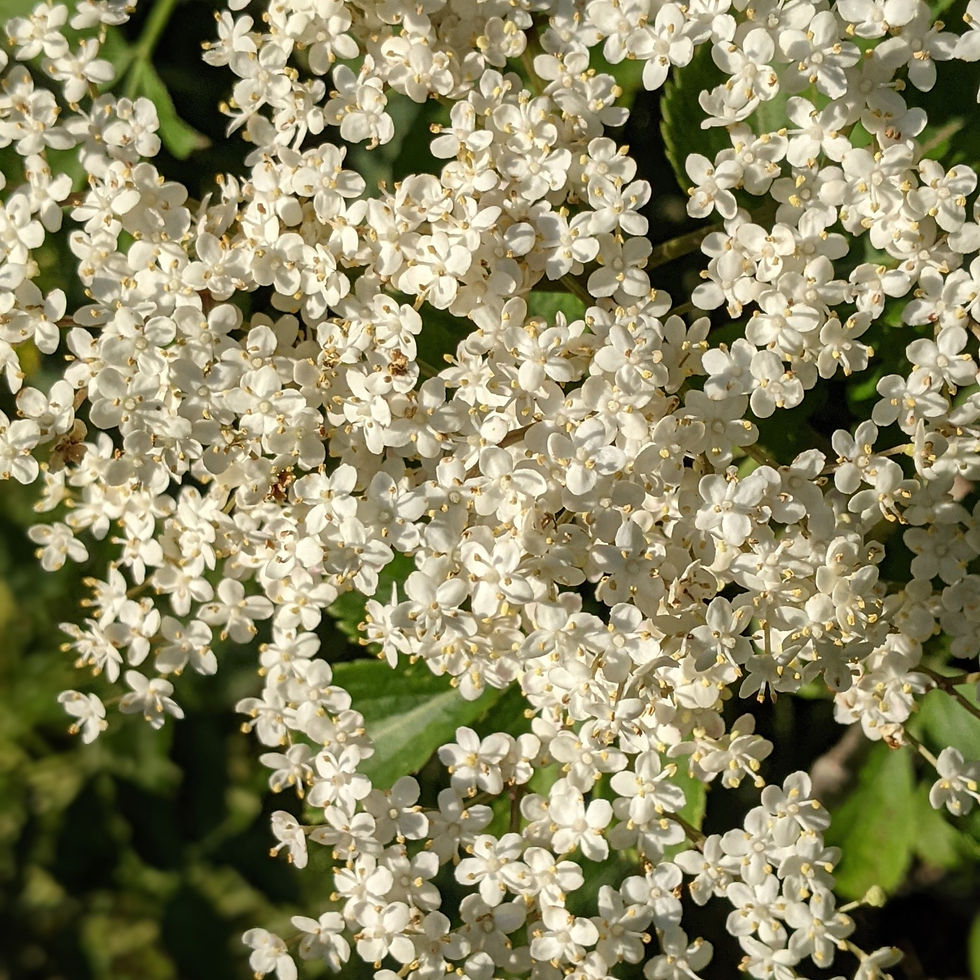Foraging For Elderberries
- The Cramlington Forager

- Sep 15, 2021
- 3 min read
A very prolific tree, the Elder tree is a common sight in hedgerows throughout the UK and during September they are heavy with delicious dark berries which are packed with medicinal benefits.
The Elder tree, or Sambucus nigra, is one of nature's gifts that just keeps on giving. In Summer we delight in hedgerows overflowing with clusters of tiny white Elderflowers, and we make use of their refreshing taste and smell to make cordials and summer teas. They are one of my favorite summer foragables and while they have now long faded away, they have left in their place one of the tastiest fruits of Autumn - the Elderberry.

How to Identify the Elder Tree
The flowers and berries of the Elder tree are one of the key identifying features, but its important to be able to identify the tree as well for certainty. Elder trees are shrub like in appearance with very distinctive bark - it is soft, deeply furrowed and gnarly, and has a unpleasant smell which comes from the chemicals held within the tree. The wood of the Elder is very brittle so don't try climbing the tree to get the best berries at the top! The leaves are green and serrated, growing in groups of six or seven along a single stem.
How to identify Elderberries
They develop first as small, hard green berries but from late August they begin to ripen, turning a deliciously dark shade of red, almost black. They hang down heavy from now red stems, making them very easy to spot against the fading green and yellow leaves of the Elder tree. The unripe, green berries are toxic so only gather those which are completely ripe, and avoid eating them straight from the tree as raw berries, or more specifically their seeds, are also considered to be slightly toxic. Cooking the berries neutralises the toxins, making them safe to eat, but be sure to remove the leaves and as much of the red stems as possible before processing as they too are toxic.
Elderberries are a particular favorite of most foragers, but they also seem to be a particular favorite of blackbirds and robins too. With any foraging comes a level of responsibility for the plants and life around us, so always be sure to forage lightly. Always try to forage across a few different locations - you can't always be sure that you'll be the only person to visit that spot, so please be mindful and leave more than enough for the wildlife that share your space too. Thankfully elderberries can be stored very easily - they can be dried or frozen to be used at a later date or stock up until you have enough to use.

Elderberries are traditionally used as a cold and flu remedy and preventative; as well as their anti-viral properties they are a good source of vitamins A and C, and fibre. To make use of their benefits, they are most commonly used to make syrup which can be bottled, stored and used for the winter months when colds and flus are most common. Spices can be added for additional benefits and flavour. A spoonful can be taken regularly as a preventative or you can use it over porridge, pancakes or mixed with hot water for a warming Winter drink.

One of my favorite ways to use Elderberries for their flavour rather than for their health benefits is to mix them in with an Apple and Blackberry crumble! They can be used in baking as you would any other berry, in muffins, cakes and sweet breads, any they are a common favourite for wine and mead making! They make delicious jams or jellies when combined with other hedgerow fruits like blackberries and rosehips too. Its such an incredibly versatile fruit and beyond washing and removing them from the stems which can be a little time consuming, they require virtually no preparation before cooking.

Elderberries are very easy introduction to foraging if you haven't done much in the way of wild food before. They ripen usually around the same time as blackberries (the ultimate autumn fruit!) and there are plenty of ways that the two can be mixed together. Wild Elderberries have been enjoyed for hundreds of years, and I'm not quite sure why they haven't made their way onto supermarket shelves, but that only adds to the joy in the anticipation of waiting for them to ripen every year!
_JPG.jpg)





Comments